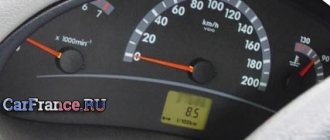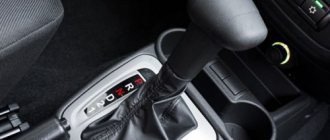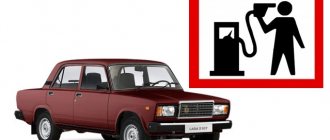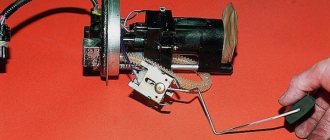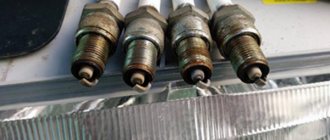VAZ 2106 is a domestic car, which is known for its durability and stability. Fortunately, all domestic cars have one big advantage - the fuel consumption of the VAZ 2106 is not high, which makes such a purchase even more successful. Of course, fuel consumption standards for the Lada 2106 in the city significantly exceed fuel consumption on the highway. The reason for this is that in the city the car is not at a stable speed, it stops, slows down, etc., such work consumes more energy.
Official data (l/km)
| Engine | Consumption (city) | Consumption (highway) | Flow (mixed) |
| 1.3 MT 64 hp (Mechanics) | 9.5 | 7.6 | 8.3 |
| 1.5 MT 72 hp (Mechanics) | 9.8 | 8.0 | 8.8 |
| 1.6 MT 74 hp (Mechanics) | 10.3 | 7.4 | 9.1 |
| 1.6 MT 75 hp (Mechanics) | 10.3 | 7.4 | 9.1 |
| 1.6 MT 75 hp (Mechanics) | 10.1 | 7.4 | 9.0 |
The first, smallest engine was the 1.3 liter version. At most, such an engine could produce a power of 64 horsepower. Its fuel consumption per 100 km was 9.1 liters in the city and 7.5 liters on the highway. Next came an engine with a displacement of 1.5 liters. He was already capable of squeezing out 72 horsepower while consuming 8.5 liters of fuel. The largest engine was a 1.6 liter unit, the power of which was 75 horsepower. This engine was already consuming 8.9 liters of gasoline. Fuel injection on all versions was carried out by a carburetor, and the transmission was only a four-speed manual.
This is interesting: What is the fuel consumption of the Lada Vesta
Choose the right engine oil
Rationale : if you use oil with a reduced viscosity, then fuel consumption decreases as the resistance decreases. Oil viscosity depends on temperature, and it is the loss of viscosity that causes the engine to “seize”
Disadvantages : none
You can see additional recommendations by looking at another infographic:
Engines and official fuel consumption rates of the VAZ-2106
Over the entire production period, the “six” was equipped with three variants of gasoline engines with a carburetor and a manual transmission with rear-wheel drive. Their advantages include:
- reliability;
- unpretentiousness;
- simplicity of design;
- low cost of repairs;
- economical fuel consumption of VAZ-2106.
The first version to appear was a 1.3 engine with 64 horsepower. With it, the “six” accelerated to the first hundred in 18 seconds, and the maximum speed reached 145 kilometers per hour. The car had the following fuel consumption figures per 100 kilometers:
- city mode 9.5 l;
- on the highway 7.6 l;
- mixed mode 8.3 l.
To meet the needs of potential buyers, they were offered a more powerful version with a 1.5 petrol unit and a power of 72 horses, a five-speed manual transmission. In this configuration, the VAZ-2106 accelerated to a maximum of 150 km/h, and reached the first hundred in 17 seconds. These figures were achieved with the following gasoline consumption per hundred kilometers:
- city 9.8 liters;
- track 8 liters;
- the average is 8.8 liters.
The most powerful and beloved by domestic car enthusiasts was the modification with a 1.6 engine with 75 horsepower - a reliable, dynamic unit. Paired with a balanced five-speed manual transmission, it accelerated the car to 155 kilometers per hour, and the dynamic acceleration to hundreds became 16 seconds. At the same time, fuel consumption per hundred increased slightly and amounted to:
- in city traffic 10.3 l;
- mixed mode 9.1 l;
- on a free road 7.4 liters.
All engines are designed for AI 92 gasoline, but can also run on other brands, both with lower and higher octane numbers.
General tips for operating a car
To minimize the influence of minor factors and achieve real fuel savings, follow a number of simple rules:
- Fill with gasoline with an octane rating of at least 92 according to the manufacturer's recommendations. If you accidentally come across low-quality fuel, try to drain it from the tank and refuel with normal gasoline.
- Maintain the recommended tire pressure of 1.8-2 atm depending on the load.
Air pressure must be checked at least once a week - During the cold season, warm up the power unit before driving. The algorithm is as follows: start the engine, let it run for 2-5 minutes (depending on the air temperature), then start driving slowly in low gears.
- Do not delay repairing the chassis; follow the procedure for adjusting the camber angles of the front wheels.
- When installing wider tires, replace stamped wheels with alloy wheels. In this way, it will be possible to compensate for the increase in the weight of the wheels and improve the appearance of the “classic”.
Installing alloy wheels instead of steel allows you to lighten the wheels by a good ten kilograms - Do not weigh the car with unnecessary external elements that increase the aerodynamic drag of the environment. If you are a fan of styling, choose a beautiful and at the same time streamlined front body kit, dismantle the old bumper.
Unlike modern cars, where the filling pipe is equipped with a mesh, emptying the tank of the “six” is much easier. Insert the hose into the neck, lower it into the container and use suction to direct the fuel into the spare canister.
Air resistance has a significant impact on engine fuel consumption. If we compare the movement at 60 and 120 km/h, then the aerodynamic drag increases by 6 times, and the speed - only by 2 times. Therefore, the triangular side windows installed on the front doors of all Zhiguli cars add 2-3% to the consumption when open.
Find out whether it is possible to refuel a full car tank: https://bumper.guru/klassicheskie-modeli-vaz/poleznoe/pochemu-nelzya-zapravlyat-polnyy-bak-benzina.html
Video: how to save gasoline in simple ways
Fuel consumption VAZ 1.3l.
The VAZ 2106 was equipped with a five-speed gearbox and a gasoline carburetor engine with a displacement of 1300 cc. and power 64 hp. The car has a top speed of 145 km/h and accelerates from zero to hundreds in 18 minutes. Fuel consumption within the city is 9.5 liters, and on the highway – 7.6-8 liters per hundred kilometers.
Real fuel consumption of VAZ 2106 1.3l.
- Andrey. Kirov. I inherited a VAZ 2106 produced in 1992 from my father. This was five years ago. Of course, at that time there were practically no “original” spare parts in the car, but the engine worked “like a clock” and never let me down. If you don’t press the gas pedal to the floor on the highway and warm up the car thoroughly in winter, then there will be no problems with it. I think that a domestically assembled engine, with proper and timely maintenance, will last for many more decades. As for fuel consumption, my 1.3 liter engine “eats” about ten liters in the city, and on the highway – within seven liters per hundred.
- Oleg. Tomsk I bought a VAZ 2106 from a neighbor in 2005 with a 1.3-liter engine. The car came off the assembly line back in 1988, so you understand that its condition was not the best. I overhauled the engine, replaced all consumables, slightly modernized the interior and drove it without problems for five years. I was also completely satisfied with fuel consumption: in the city no more than ten liters, and on the highway during normal driving it was possible to keep within 7.5-8 liters.
- Sergey. Adler. I bought a VAZ 2106 from 1985 specifically for taxi work. The previous owner loved his car, so I got it in very good condition. I drove the “Six” for almost seven years and during this time it did not create any special problems for me. If we talk about fuel consumption, then I got about ten liters in the city and eight on the highway.
- Vladimir. Kazan. The VAZ 2106 with a 1.3-liter engine is a good domestic car that, with proper care, can faithfully serve for several decades. I bought my ’85 “six” in 2001 in order to take my family to the dacha and visit relatives. In addition, I also drove the car for work, so it rarely came into my garage. During the entire period of operation, I never looked into the engine, since there was no need for this, it worked properly and did not let me down. In terms of fuel consumption: in the city with normal traffic it was up to ten liters, and on the highway - 8-8.5 liters per hundred.
- Alexei. Ulyanovsk VAZ 2106 1.3 liter - this is my first car. I bought it new off the production line in 2001 and drove it for almost ten years. Of course, immediately after the purchase I had to tighten up a few things and blow out the bottom, but otherwise I had no complaints about the car. The machine is a real “workhorse”; I have no doubts about this during the entire time I used it. In terms of consumption, I can say the following: in the city I got from eight to ten liters, and on the highway (if I didn’t press the accelerator pedal to the floor) - 8-8.5 liters per hundred kilometers.
Check your tire pressure regularly
Rationale : the lower the pressure, the higher the fuel consumption. At low pressure, the contact area with the road is larger and rolling friction is stronger. If you drive on wheels inflated to 1 atmosphere instead of 2, then you lose an extra 2-3 liters per tank. The advice is good for imported tires, as they hold pressure well, but our domestic Kama needs to be checked weekly.
In case of strong pumping, fuel consumption is noticeably lower, but all the bumps become noticeable, and the ride becomes uncomfortable. And if the pressure reaches 3 atmospheres, then the area of contact with the ground is so small that the braking distance increases quite sharply, which is dangerous. It is even more dangerous to overinflate wheels in winter, when a large area of tire adhesion to the road surface is especially important.
The acceptable pressure range is 2.2 – 2.4 atm.
In addition, you need to regularly monitor the condition of the tire treads. Heavily worn tires increase fuel consumption, including due to lateral deviation from a straight line.
Disadvantages : none
Technical characteristics of Lada
If we talk specifically about the VAZ 2106, then this car fully corresponds to its price category, it is equipped with everything necessary, and has an attractive design.
The VAZ 2106's gasoline consumption per 100 km is low, about 7 liters on the highway, and about 10 liters in the city
. This is normal consumption for a car with such power, but it is worth noting that such fuel consumption of 2106 per 100 km is beyond the means of many car enthusiasts.
To avoid problems with servicing your VAZ 2106, you should pay attention to some things even when purchasing it:
- The price of the car itself;
- The approximate price you are willing to spend on its maintenance per year;
- Approximate cost of gasoline for a car per month;
- Unplanned capital investments;
Only by calculating the approximate costs of it for a year, and correlating it with your capabilities, can you determine your chances of properly servicing such a car.
Fuel consumption on a carburetor VAZ 2106 also does not exceed the norm, and is not particularly different from the usual consumption of this VAZ, because the volume of gasoline burned can fluctuate, depending on many factors: weather conditions, the condition of the car, driving habits, the quality of gasoline and oil.
If you have already decided to buy this car, but are not informed about possible or frequent breakdowns of this model, its weak points and the real fuel consumption of the VAZ 21063 - then experienced motorists, former owners of a VAZ of this model or just experienced auto mechanics.
Only after consulting with them, you will be able to make the right decision, or, perhaps, you will be insured against unpleasant situations and possible breakdowns.
This is interesting: What should be the gas consumption for a VAZ 2110
Fuel supply diagram
To find out the reasons for the excessive consumption of the fuel mixture, you should understand how the fuel supply system of the 2106 car is designed. The gas tank in the six is located in the luggage compartment, fixed and separated by a plastic partition. The tank is equipped with a neck for filling gasoline; it is brought out through the hatch of the rear right wing and sealed to prevent the penetration of dust and dirt particles into the tank.
To regulate the pressure of gasoline and air vapors, the gas tank is equipped with a plastic ventilation pipeline laid in a loop. The gasoline level indicator is fixed through a rubber gasket. This rheostat-type sensor is located on a flange, which is welded to the top of the tank. The sensor is a block element with a tube (fuel intake) with a mesh filter at the end. Changing the level of the fuel mixture causes the float-shaped sensor to start moving, changing the resistance of the rheostat. Because of this, the current that the sensor-pointer system passes through changes, and, accordingly, the pointer (arrow) moves.
The pipeline, consisting of special rubber in a fabric weave, is fastened and fixed to the fuel line. All holes for hoses or tubes are hermetically sealed with rubber bushings. To gently clean gasoline, a filter is placed in front of the pump. The power system cannot do without this filter, which retains mechanical particles and cleans the mixture to the required level. Other filters that contain the pump, gas tank or carburetor cannot cope with such tiny fragments. A mechanically driven fuel pump (diaphragm type) creates excess pressure and injects the fuel mixture into the carburetor.
Located to the left of the engine cylinder block, it also has a manual fuel pumping lever. The carburetor produces the desired composition of the air-fuel mixture and regulates its intake into the engine cylinders. The carburetor is controlled from the driver's seat using the accelerator pedal; it is connected to the drive lever of the first carburetor chamber by a system of rods and hinges.
Carburetors on VAZ models are of two types - “ozone” and “weber”.
Fuel consumption VAZ 1.5l.
VAZ 2106 1.5. It was equipped with a gasoline carburetor engine and a five-speed manual transmission. The engine displacement is 1452 cc and power is 72 hp. Engine torque is 104 Nm at 3400 rpm. The car has a top speed of 150 km/h and accelerates from zero to hundreds in 17 seconds. Fuel consumption VAZ 2106 1.5l. in the city it is 9.8 liters, on the highway - 7.4 liters per hundred kilometers.
Real fuel consumption of VAZ 2106 1.5l.
- Vladislav. Samara. Six years ago I bought a second-hand “six” with a one and a half liter engine for work and I drive it to this day. What can I say, in my opinion, this is the best car for our roads. In addition, considering that the car rolled off the assembly line back in 1988, its condition can be said to be ideal. If your head “cooks” and your hands grow from the right place, then you can use the “six” for more than a dozen years. In terms of gasoline consumption, my average is ten liters in the city and up to 8.5 on the highway.
- Dmitriy. Kazan. My “swallow”, after a major overhaul in 2001, still doesn’t drive, but flies! I completely overhauled the engine and gearbox, changed all the consumables and slightly modernized the interior. Since then there have been no major problems. In terms of gasoline consumption, I get about ten liters when driving around the city and no more than nine on the highway.
- Egor. Samara. I inherited my “six” with a one and a half liter engine from my father in 1995. My father loved the car very much and looked after it carefully. The machine served me faithfully for ten years, after which I sold it. It seems to me that for our expensive VAZ 2106 it is exactly what we need. The machine is stable, durable, convenient, and most importantly, not expensive to maintain. In terms of gasoline consumption, I got no more than 10 liters in the city (in normal traffic) and up to nine liters on the highway.
- Ivan. Saint Petersburg. I bought the car off the production line in 1993. Of course, for greater comfort and safety I had to tighten some parts and blow out the bottom, but otherwise I was completely satisfied with the car. Playful, easy to control and stable. In addition, the suspension is not very stiff, and the interior is spacious and comfortable. I sold my “six” five years ago and today I already regret it. The car “eats” relatively little, and maintenance costs pennies. My gasoline consumption averaged up to 10 liters within the city and 7.5-8 liters on the highway, which I think is quite normal.
- Victor. Kostroma. I bought a used 1993 Six from a work colleague. What can I say, the car is a real classic of the domestic automobile industry. A spirited engine, a relatively soft suspension, a comfortable interior that warms up quickly in winter. In addition, if the hands grow from the right place, then maintenance costs mere pennies. Fuel consumption is also within normal limits: in the city up to ten liters, and on the highway (if you don’t drive) you can keep within 7.5-8 liters per hundred kilometers.
- Nikita. Moscow. I bought a “six” second hand after a major overhaul. At that time, it already had 7,000 kilometers on it. Today the mileage is 25,000 km, and I still have no complaints about the machine. It picks up speed quickly, has good stability and controllability, and most importantly, is inexpensive to maintain. In terms of gasoline consumption, everything also suits me: in the city with heavy traffic it turns out to be up to ten liters, and on the highway with normal driving you can keep within 8 liters.
- Victor. Stavropol. It seems to me that the “six” with a one and a half liter engine is an ideal car for those who are just acquiring driving skills and are trying to figure out how everything works in the engine, gearbox, etc. The car is easy to control, stable and playful. I’ve been riding mine for five years now and I don’t have any particular complaints, although I bought it used. Gasoline consumption is also within normal limits: in the city I get no more than ten liters, and on the highway, if I don’t drive, it’s 7.5-8 liters.
- Natalia. Belgorod. My husband bought a VAZ 2106 from 1988 from a friend. He said that this is an ideal option for acquiring driving skills. And today I understand that he spoke the truth. We made a capital investment immediately after the purchase, and to this day we have no complaints about the machine. Of course, this is not a foreign car with climate control and leather seats, but the car is quite enough for everyday movement around the city. In terms of gasoline, I get about ten liters in the city and 8-8.5 on the highway.
Economy driving skills
Drivers are taught proper driving techniques at a driving school. When operating the domestic “classic” VAZ 2106, you need to take into account a number of points:
- The first gear of the car is quite “short”. You shouldn’t rev the engine too hard; once you’ve started moving, go to second speed.
- Frequent sudden accelerations and stops are a real scourge for any car; along with excessive consumption of gasoline, the wear of parts and components accelerates. Move more calmly, try to stop as little as possible, use the inertia (rolling) of the car.
- On the highway, maintain cruising speed at all times. The optimal value for the “six” with a four-speed gearbox is 80 km/h, with a five-speed gearbox – 90 km/h.
- When coasting down a mountain, do not turn off the speed - brake the engine and watch the tachometer. When the needle drops below 1800 rpm, shift to neutral or low gear.
- In a city traffic jam, don’t turn off the engine in vain. If the idle time does not exceed 3-4 minutes, stopping and starting the engine will “eat up” more fuel than idling.
Moving along busy city streets, experienced drivers monitor the signals of distant traffic lights. If you can see a green light in the distance, there is nowhere to rush - by the time you get there, you will come under a red one. And vice versa, if you notice a red signal, it is better to speed up and drive under the green one. The described tactics allow the motorist to stop less at traffic lights and thus save fuel.
Against the backdrop of rising fuel prices, driving outdated cars becomes doubly expensive. The “six” needs to be constantly monitored and repaired on time, so as not to pay extra money for gasoline. Aggressive driving is not at all compatible with carburetor “classics”, where the power of the power unit does not exceed 80 hp. With.
Technical features affecting fuel economy
From the functional and technical side, fuel consumption is affected by:
- condition of the cylinder-piston group - when worn, consumption increases by 20-25%,
- coolant temperature – when it decreases relative to the optimum, the overconsumption increases by 8-10%,
- high oil density, especially in winter, when friction in the engine and transmission increases losses,
- clutch slipping,
- a jammed brake caliper and an unadjusted brake system as a whole,
- underinflated tires (a more economical option - slightly overinflated by 0.2 atm.),
- over-tightened wheel hub bearings add another 10-15% to the consumed volume of fuel.
